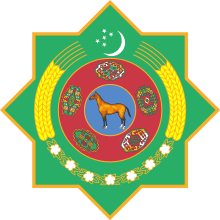Agriculture in Turkmenistan
Agriculture in Turkmenistan is a significant sector of the economy which contributes 12.7% of the GDP and employs 48.2% of the workforce. However, only 4% of the total land area is cultivated.
Because of the arid climate, irrigation is necessary for nearly all cultivated land. Minor crops of citrus fruits, dates, figs, melons, pomegranates, olives, and sugarcane are grown in some parts of the country. Sesame and pistachios are also grown in smaller quantities. The two most significant crops are cotton - which is grown on half of the country's irrigated land, and wheat. Although Turkmenistan was formerly the world's 10th largest cotton producer, exports have fallen by 50% in recent years. This is due in large part to the environmental difficulties of irrigation in a desert environment. Cotton cultivation in Turkmenistan required a large amount of water to be diverted from the Amu Darya river and also introduced a great deal of fertilizer into the river. As a result, cotton cultivation in Turkmenistan is one of the factors causing the drying up of the Aral Sea.
Animal husbandry makes up a great deal of agriculture in Turkmenistan, despite the fact that the arid climate presents difficulties in producing sufficient feed for the animals. The majority of animals in the country are sheep (usually of the Karakul breed) which are primarily raised for wool and skins. Chickens, cattle, goats, and pigs are also raised.
The Akhal-Teke horse is also raised in Turkmenistan, and is a source of national pride. It is featured on the coat of arms of Turkmenistan.
Changing farm structure
Up to 1991, agriculture in Turkmenistan (then Turkmen SSR), as in all other Soviet republics, was organized in a dual system, in which large-scale collective and state farms coexisted in a symbiotic relationship with quasi-private individual farming on subsidiary household plots. The process of transition to a market economy that began in independent Turkmenistan after 1992 led to the creation of a new category of midsized peasant farms, known as daihan or dayhan farms (Turkmen: daýhan hojalyk, Russian: дехканские (фермерские) хозяйства), between the small household plots and the large farm enterprises. In 2002 there were more than 5,000 such private farms in Turkmenistan, operating on 81,000 hectares. The former collective and state farms were transformed in 1996-1997 into associations of leaseholders. So-called “peasant associations” (Turkmen: daýhan berleshik) were summarily organized by presidential decree in place of the traditional collective and state farms, and each association was instructed to parcel out its large fields to individual leaseholders (typically heads of families). The average leasehold within a peasant association is 4 hectares, whereas a dayhan farm averages 16 hectares.[1]
The 1992 constitution of independent Turkmenistan recognized private land ownership. Yet the Land Code, which is the permanent law that interprets the constitution on land matters, stipulates that privately owned land in Turkmenistan is non-transferable: it may not be sold, given as a gift, or exchanged. The notion of private landownership in Turkmenistan is thus different from the accepted notion in market economies, where ownership implies full transferability of property rights. In practical terms, all land in Turkmenistan is controlled by the state, and it is basically the state that allocates land use rights to both leaseholders and dayhan farmers. The allocation of land use rights typically involves assignment of annual production targets in cotton and wheat. Leaseholders receive land in use rights from the state through the intermediation of the local peasant association (the lease term is usually 5–10 years). The lease is nontransferable: if a family cannot farm, the leasehold reverts to the association for reassignment. Dayhan farmers receive land directly from the state. Initially, the land is granted in use rights, but once the farmer has established a record of successful farming (within two-three years), the land is transferred into "private ownership" and the farmer receives a special "land ownership certificate" from the authorities. On the other hand, if the farmer fails to achieve satisfactory results, the land may be taken away by the state, even if it has the status of private ownership.[1]
References
- 1 2 Lerman, Zvi; Stanchin, Ivan (2004). "Institutional Changes in Turkmenistan's Agriculture: Impact on Productivity and Rural Incomes". Eurasian Geography and Economics. 45 (1): 60–72. doi:10.2747/1538-7216.45.1.60.
